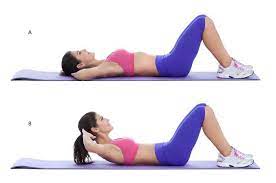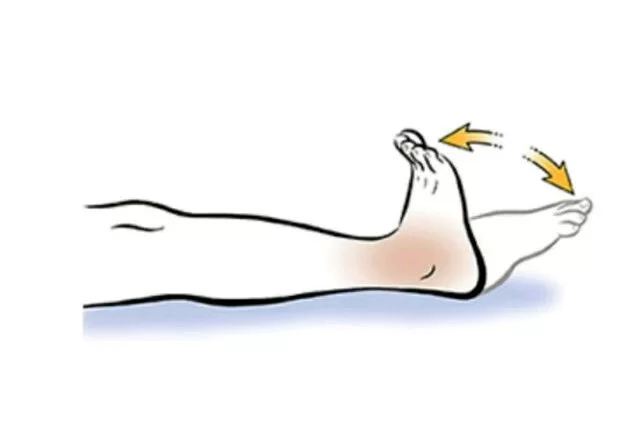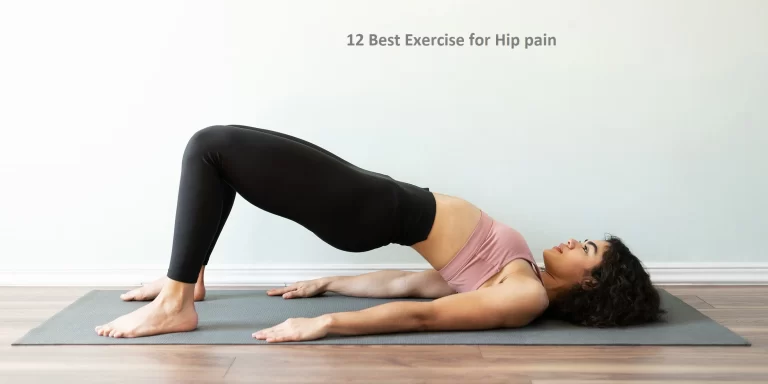Supraspinatus muscle strengthening exercise
Table of Contents
What is the Supraspinatus muscle-strengthening exercise?
- Supraspinatus muscle strengthening exercise is a great way to increase the function of the shoulder as well as the scapular region & increase the fitness level & stamina that helps to improve performance in a day-to-day activity or in sports.
- The supraspinatus muscle is small in the upper back. This muscle supports the rotator cuff, which is located around the shoulder joint.
- Tears in the rotator cuff generally start in the supraspinatus tendon, and if the patient does not give proper care, may extend to other muscles within the rotator cuff.
- The supraspinatus muscle supports the top of the upper-arm bone while upper-limb functional activities. If the supraspinatus is weak or even injured & it may not provide this support, the patient is more likely to have shoulder issues. Thus, strengthening exercises of the supraspinatus muscles is necessary to provide better support to the shoulder & prevent its injury.
- The supraspinatus is an upper back muscle that works as a shoulder abduction & stabilization. It is also one of the four shoulder muscles that form up the rotator cuff, helping to raise the arm away from the side of the body.
- The supraspinatus is a small muscle in the scapulae that may be the origin of a lot of pain if not taken care of. The action of the supraspinatus muscles is the Initiate abduction & depress the humeral head against the upward pull of the deltoid. This muscle & tendon travel slightly obliquely from posterior to anterior, allowing this to contribute to external rotation also.
Health benefits of Supraspinatus muscle strengthening exercise
- This stabilizes the shoulder & upper back muscles.
- Increases good blood circulation in that area.
- Improves posture.
- Reduce neck & head pain.
- Increase range of motion of shoulder joint.
- Decrease tightness in the shoulder joint.
- Improve the shoulder function.
Different types of Supraspinatus muscle strengthening exercises
Prone External Rotation
- How to do this strengthening exercise: To do this exercise a patient has to Lie on the tummy with the left upper arm hanging halfway off the side of a bed or bench at shoulder level.
- Grab a 1- to 2-pound weight in the left hand, and rotate the forearm & hand upward until the forearm is parallel with the ground.
- Hold this position for 2 to 4 seconds, then return to the initial position.
- After completing ten repetitions, perform the same exercise with the right arm.
- This exercise strengthens both the infraspinatus & supraspinatus muscles and helps to improve shoulder posture.
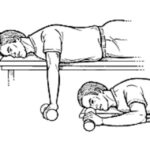
Resisted External Rotation
- How to do this exercise: To do this exercise a patient has to stand with the right side facing the door.
- With one end of the resistance band secured in the door handle, hold the other end in the left hand.
- Keep the left elbow flexed up to a ninety-degree angle & resting firmly against the side.
- Rotate the left forearm away from the door as much as you can without turning the torso.
- As you do this, squeeze the shoulder blade down as well as the back.
- Do not let the elbow leave the side. After a 2 to 4-second hold, release the shoulder blade as you rotate the forearm back to the starting position. Do 10 repetitions before switching to the right side.

Prone Elevation
- How to do it: To perform this exercise, first of all, the patient has to Lie on the tummy with the right arm hanging off the edge of a bed. Hold a one to two-pound weight in the right hand.
- With the right thumb facing the sky, raise the arm slightly above ear level until it is even with the bed. Do not shrug the shoulder or lift the shoulder off the bed as you perform.
- Hold the right arm in this position for one to two seconds & then lower it back down.
- After completing this ten times, repeat with the left arm.
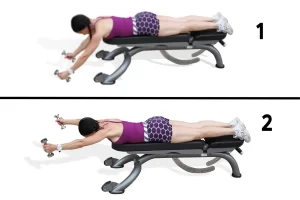
Side-Lying External Rotation
- How to do this strengthening exercise: To do this exercise the patient has to Lie on the left side with the right elbow flexed at a ninety-degree angle & the palm resting against the abdomen. Grab a 2-pound weight in the right hand.
- Set the right shoulder blade down and back. Then, rotate the right palm & forearm away from the tummy until the forearm is straight up and down.
- Maintain this position for 2 to 4 seconds & then slowly rotate the arm back to the belly.
- After 10 repetitions, repeat with the left arm.
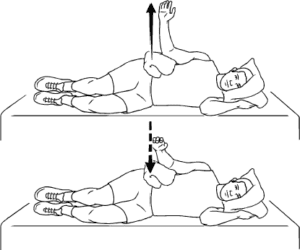
Full Can

- How to do this strengthening exercise: To do this exercise a patient has to stand on one end of a resistance band & hold the other end in the left hand.
- The patient can also use a 1- to 2-pound dumbbell in place of the resistance band.
- With an extended elbow & the thumb positioned up, elevate the arm at a forty-five-degree angle with the body.
- Once a patient has lifted the arm slightly above ear level, hold this position for one to two seconds & then slowly lower back to the left side.
- Do not shrug the shoulder as you perform.
- After 10 repetitions, repeat the exercise on the right side.
Prone Full Can Raise
- How to do this strengthening exercise: To do this exercise a patient has to Lie flat on the tummy on the bench or bed.
- Start with the arms facing down toward the ground, slightly in front of the shoulders, as opposed to directly under the shoulders, with the palms facing forward.
- Elevate the arms directly to the side until they reach about shoulder height, then slowly lower.
- The prone full can or shoulder T also called horizontal abduction in external rotation, is designed to provide dynamic stability, optimal muscle length, & tension, as well as proper positioning of the scapula & shoulder girdle.
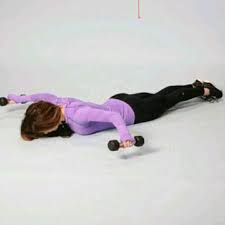
T-Band Rows
- How to do this strengthening exercise: To do this exercise the patient has to Wrap the band around a pole or any immovable object at belly button height.
- Hold on to both ends of the band so that there is an equal length on both sides, while also keeping tension in the band at the starting position.
- Start with the elbows extended with an upright trunk (maintained throughout), & then pull the elbows straight back, keeping them tucked in.
- Pinch the shoulders while pulling the band back. Imagine trying to squeeze the pencil between the shoulder blades.
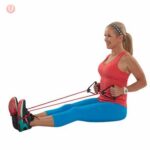
Incline Reverse Lateral Dumbbell Raise
- How to do this exercise: To do this exercise the patient has to Lie face-down on the inclined bench.
- Grab a dumbbell in both hands below the chest with the arms fully extended.
- Raise the arms to shoulder height, arcing the weights away from each other
- Return to the starting position.
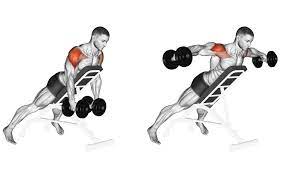
When did a patient not do the supraspinatus strengthening exercise?
- If the doctor advised her to take rest.
- If a patient feels any pain or even discomfort while this exercise then stop immediately & consult the therapist.
- If the arm bone is recently fractured.
- If the muscle is recently injured.
FAQ
The subscapularis tendon, at one point, was thought of as the forgotten tendon, with “hidden lesions” that referred to partial tears of this tendon.
Jobe’s test (or the “empty can” test) assesses supraspinatus function. The patient places a straight arm in about 90 degrees of abduction and 30 degrees of forward flexion, and then internally rotates the shoulder completely. The clinician then attempts to adduct the arm while the patient resists.
A predisposing factor is resistive overuse. The supraspinatus tendon of the rotator cuff is involved and affected tendons of the musculoskeletal system and becomes degenerated, most often as a result of repetitive stresses and overloading during sports or occupational activities.
The supraspinatus muscle functions to initiate abduction and depress the humeral head against the upward pull of the deltoid. The muscle and tendon travel slightly obliquely from posterior to anterior, allowing it to contribute to external rotation as well.
It takes six to eight weeks for the tendon to heal to the bone. Complete recovery time varies by size of the tear. For a small tears, full recovery time is about four months, for large tears, six months. For severe, massive tears, a complete recovery can take anywhere from 6 to 12 months

